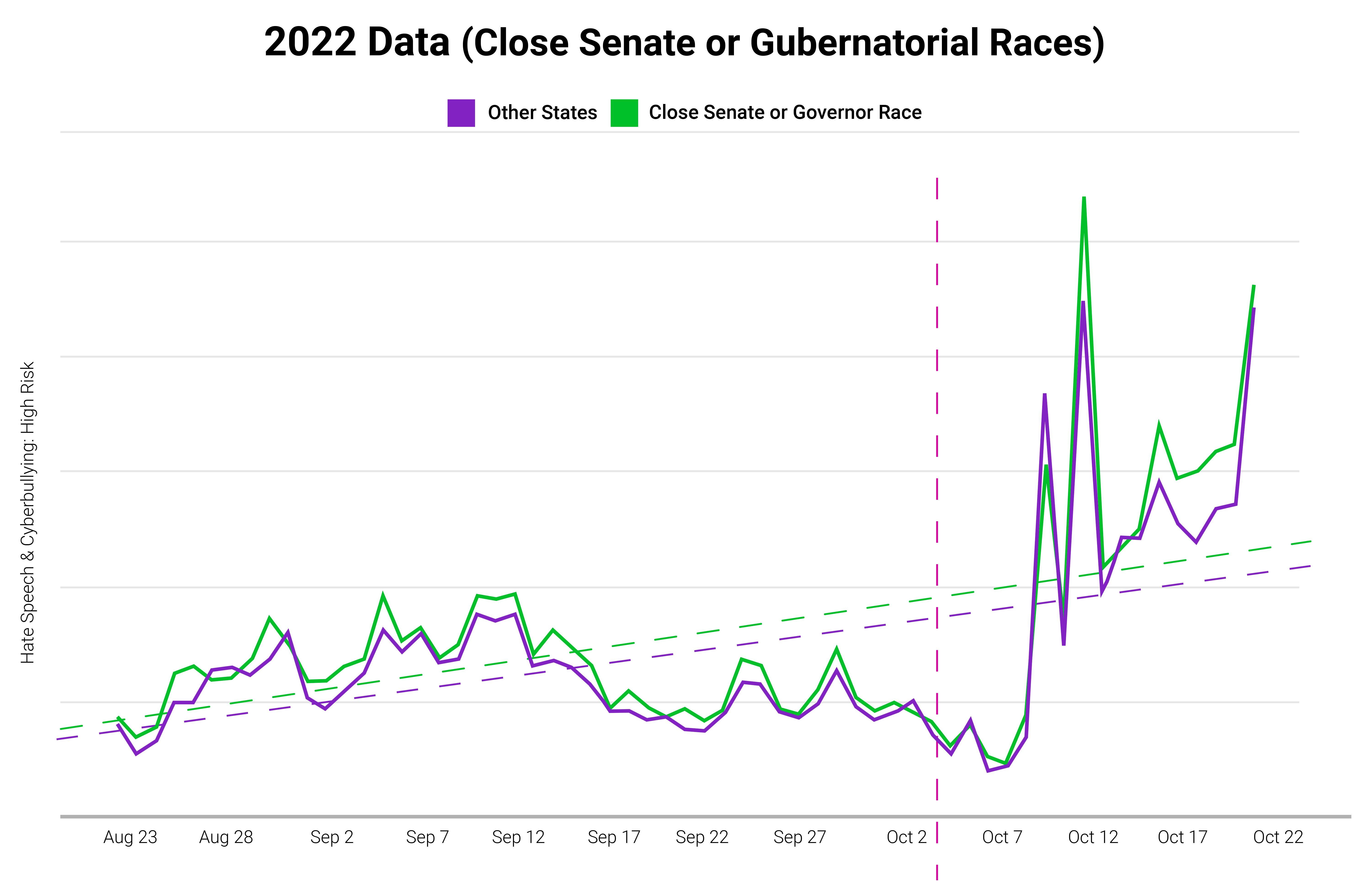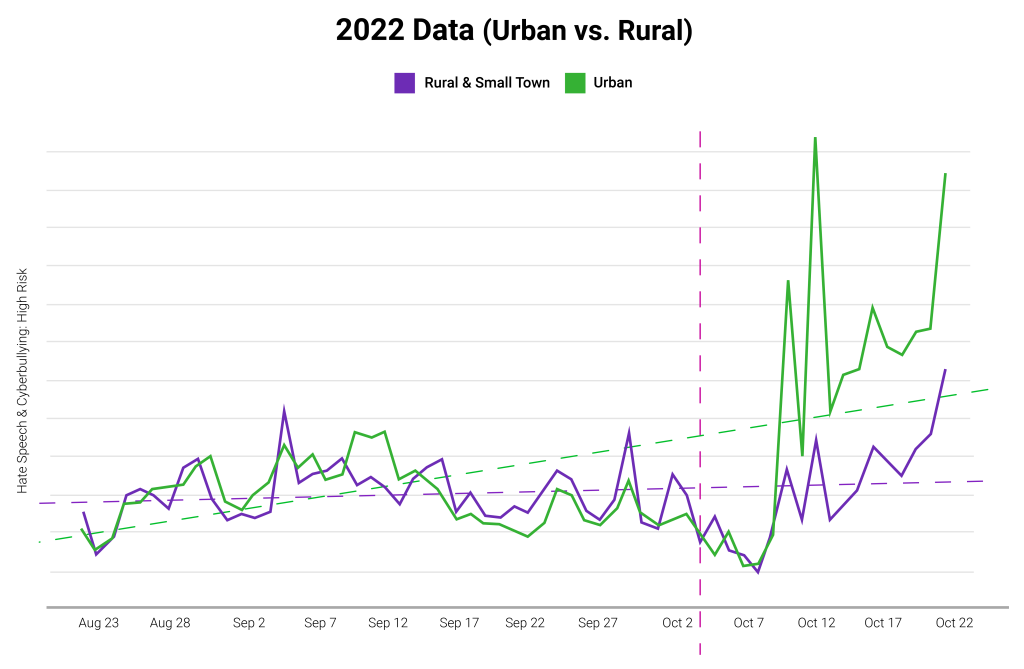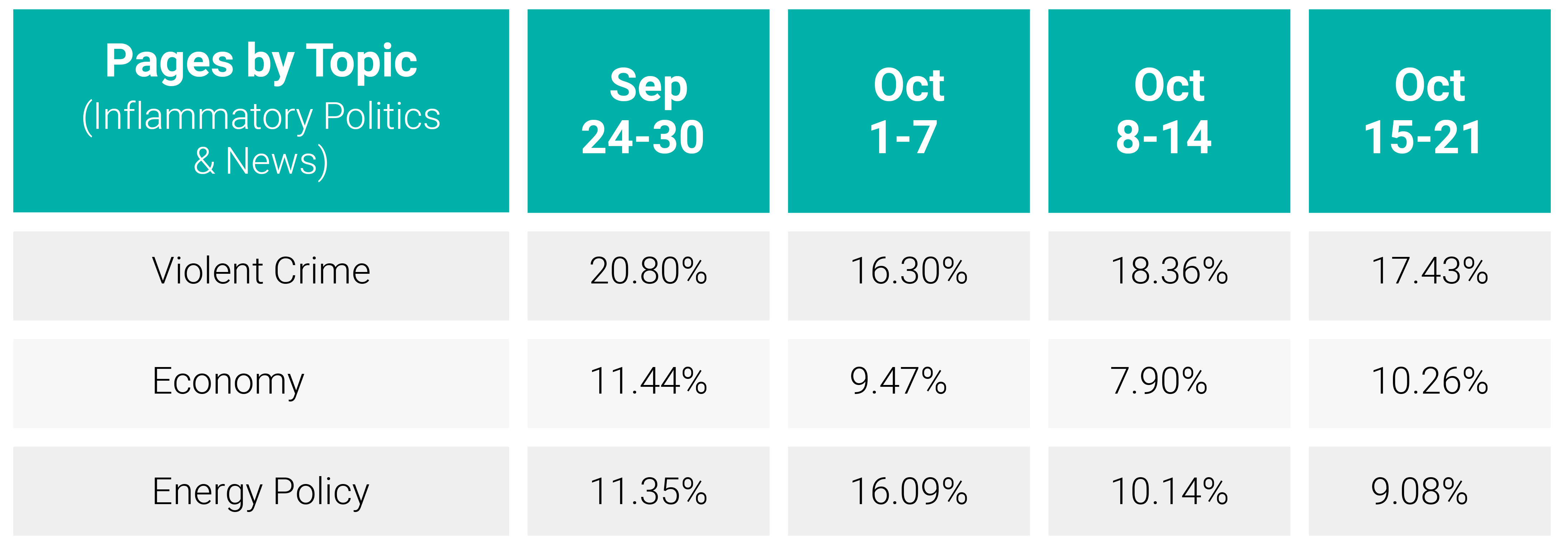High-Risk Hate Speech rates across all states nearly doubled during the weeks of October 5 – 21 when compared with rates seen over the late summer and early fall (August 22 – October 4). Although DV’s inaugural election task force blog detailed rising rates of hate speech and inflammatory content that includes disinformation, this surge suggests a particularly volatile news cycle may be setting off a cascade of incendiary content. The analysis below provides an overview of the trends emerging as the midterms approach. Please see the appendix for a full list of definitions of terms used throughout this post and notes about DV’s methodology.
High-Risk Hate Speech Snapshot
DV saw four distinct spikes of High-Risk Hate Speech occur on October 10, October 12, October 16 and October 21. These spikes coincide with confirmation on the 10th that Twitter banned Kanye West (who is now legally known as Ye) following anti-Semitic posts; the ruling on the 12th in the Sandy Hook defamation case that Alex Jones must pay $965 million in damages; the final January 6 committee hearing, which was held on the 13th; and the official subpoenaing of former President Donald Trump on the 21st.
High-Risk Hate Speech Rates (States with Close Statewide Elections versus All Other States)

Key Takeaways
- The rate of High-Risk Hate Speech draws closer between states with close election races and those without close races
Although states with close senatorial and gubernatorial races previously displayed higher rates of High-Risk Hate Speech as compared with all other states, the rate of increase in High-Risk Hate Speech rose steadily in both groups of states for the weeks of October 5 – October 21.
The average rate of High-Risk Hate Speech for states with close elections was 94% higher during these two weeks relative to the rates seen for August 22 – October 4. And the rate in states without close elections was 95% higher for the same time period.
- Urban areas responsible for the majority of the increased rate in High-Risk Hate Speech
The overall rate of High-Risk Hate Speech rose by 95% during the weeks of October 5 – October 21, but a stark difference emerged between urban and rural areas, which DV defines based on the rural-urban commuting area code (RUCA) classifications from the US census. For this analysis, areas designated by RUCA as metropolitan and micropolitan, according to the RUCA are grouped as urban while the remaining areas are grouped as rural.
High-Risk Hate Speech increased by just 7% in rural areas during October 5 – October 21 as compared with August 22 – October 4. During this same period, urban areas saw a 98% increase in High-Risk Hate Speech.
High-Risk Hate Speech Rates (Urban Areas vs. Rural Areas)

Topics Surrounding the Midterm Elections – and Those Prevalent Across Inflammatory Politics and News
Abortion remains the most prevalent election-related topic among those DV is tracking based on categories from Pew Research (described below), but it has begun trending down the past two weeks. And while Supreme Court appointments were the second most prevalent issue tracked the week prior (32.55% during October 8 – October 14), this has now dropped to fourth on our list (17.25%).

Violent crime has remained the most prevalent voting issue for four weeks running among the pages DV sampled that are classified as Inflammatory Politics and News. And while the economy surpassed energy policy over the past seven days, both remain in the top three issues DV tracked across Inflammatory Politics and News content.

Abortion has also remained the fourth most prevalent topic in our sample of pages categorized as Inflammatory Politics and News. But it has trended down from a height of 10.15% during September 24 – September 30 to 6.09% of sampled Inflammatory Politics and News pages during October 15 – October 21.
Top 5 States Seeing the Highest Rates of Hate Speech and Inflammatory Politics and News
The latest geographic ranking of High-Risk Hate Speech and Inflammatory Politics and News by rate during the weeks of October 5 – October 21 shows Mississippi and Wyoming with the most in each category respectively.
- Top 5 High-Risk Hate Speech States:
- Mississippi
- Louisiana
- Georgia
- Alabama
- South Carolina
- Top 5 Inflammatory Politics and News (IPN) States:
- Wyoming
- Oklahoma
- Ohio
- Texas
- West Virginia
What to Know As the Midterms Draw Closer
This week’s findings – particularly the spikes in High-Risk Hate Speech – underscore just how unpredictable an election news cycle may be. To help advertisers keep up with new issues, the DV Election Task Force monitors election and political content around the world in real time. If you have questions about brand safety and suitability as it pertains to the election news cycle, please reach out to Sales@DoubleVerify.com.
Appendix
DV analyzes billions of impressions a day spanning websites, mobile apps, message boards and blogs to help keep brands safe from appearing alongside content they deem unsafe or unsuitable. Publishers promoting specious or racially biased/motivated claims are classified into DV’s Inflammatory Politics and News and Hate Speech categories.
DV’s ongoing analysis of category traffic rates associated with High-Risk Hate Speech began on August 1 and compares states with close Senate and Gubernatorial races to those without any close races. Between August 1 and August 22, the average rate of High-Risk Hate Speech was the same for both subsets of states. As the midterm election cycle went into full swing, we observed that the average rate of High-Risk Hate Speech increased markedly.
How DV Defines Close Races, Rural and Urban Areas and Top Voting Issues
Close Races: DV’s list of close races is composed of “battleground” races identified by the nonprofit and nonpartisan online political encyclopedia Ballotpedia.
Rural and Urban Areas: The subgroups we designated as “urban” and “rural & small town” were derived using the rural-urban commuting area code (RUCA) classifications from the US census, listed as: metropolitan, micropolitan, small town and rural. Any areas designated metropolitan and micropolitan were grouped as “urban” in our analysis, while the remaining areas were grouped as “rural & small town.”
Tracking Topics Among Election-Related and Inflammatory Politics and News Web Pages
The DV ontology team uses machine learning to analyze web page content and identify topics being discussed. This capability allowed DV’s task force to track the frequency and prevalence of specific topics being mentioned over time.
Beginning in mid-September, the ontology team identified pages where midterm elections were mentioned and tracked the percentage of pages where the top 10 midterm voting issues appeared (i.e. % of total sample). The top 10 voting issues we tracked (per Pew Research) are listed here alphabetically:
- Abortion
- Economy
- Education
- Energy Policy
- Gun Policy
- Health Care
- Immigration
- Supreme Court Appointments
- Violent Crime
- Voting Policy
Beginning the week of September 24 – September 30, DV began analyzing the percentage of pages that mentioned these topics and were also categorized as Inflammatory Politics and News.
Glossary of Terms
Category Traffic Rates: Category traffic rates are defined as the percentage of all DV monitored ad calls that were adjacent to content classified within a specific category. This serves as a proxy for overall traffic trends.
Hate Speech/Hate Speech & Cyberbullying (overall category definition): These terms may be used interchangeably and refer to content that is related to biased, derogatory, or offensive actions towards any individuals or groups. Content that may incite violence against individuals or groups within a protected class is also within the category.
- Please note, the overall category is not limited to instances of harmful language or behavior; it also includes content about such language or behavior, such as news coverage about a hate crime or cyberbullying, as well as content about groups that are associated with such activities.
High-Risk Hate Speech/Hate Speech & Cyberbullying (High Risk): These terms may be used interchangeably and refer to content that includes hate speech or derogatory terms in a demeaning, harmful manner; discussion of hate crimes, hate groups, hate speech, and cyberbullying in user-generated and/or unmoderated content; content that promotes or glorifies hate groups; content that provides information on how to commit cyberbullying or hate crimes; content that is related to biased, derogatory or offensive actions towards any individuals or groups; content that may incite violence against individuals or groups within a protected class is also within the category.
Inflammatory Politics and News: News or political content associated with or exhibiting inflammatory points of view; potentially fake, unreliable or unsubstantiated information; significant political intolerance, hateful or threatening rhetoric; or other significantly controversial elements.
Previous Election Coverage

